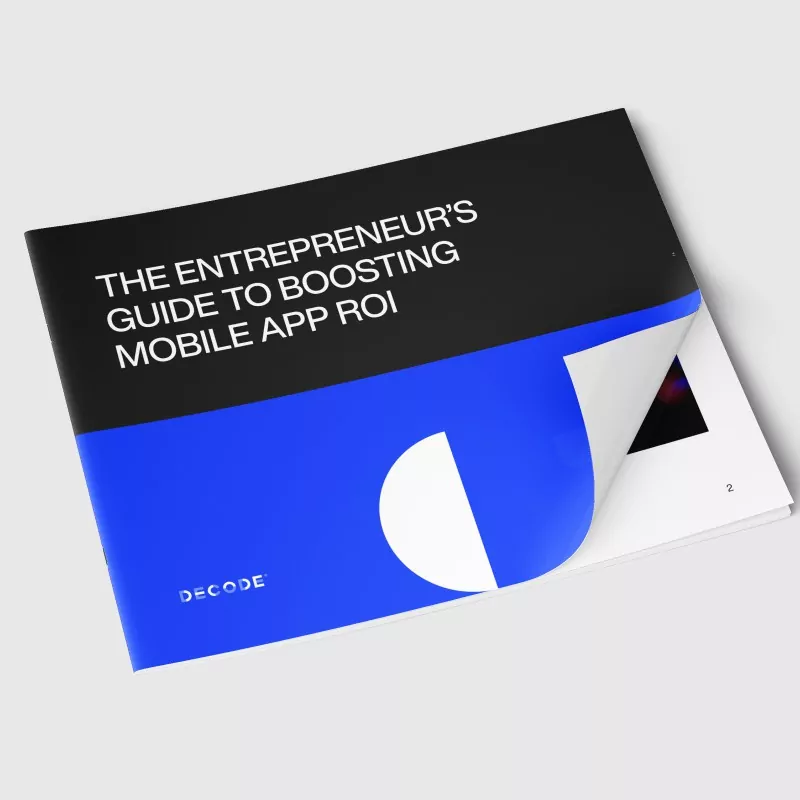Just like every other intellectual product, mobile apps can earn you a great deal of revenue. Additionally, even if you’re not looking to get rich off your app, you need money to pay bills and keep the app running.
If you go about it right, you can monetize your mobile app using essential strategies such as in-app advertising and email marketing. To ease the learning curve, we’ve compiled the best tips and methods we’ve used for app monetization in the past.
How Much Money Can an App Make?
When building an app, it’s normal to get curious about just how much you can make from it. For mobile apps, the prospects are pretty huge.
Considering that more than half (51.53%) of web traffic comes from mobile devices (excluding tablets), you have a good chance of earning a decent amount of money with a good mobile app.
Get your free copy and find out how successful entrepreneurs define parameters of success!
If you’re yet to be convinced, you’ll be even more delighted to learn that 90% of mobile usage time is spent within apps.
In 2016 alone, mobile apps successfully generated a revenue of $218.2 billion. And the numbers keep increasing with projected revenue of $581.9 billion by the end of 2020.
Most of this revenue seems to be coming from in-app purchases.
Research from ZDNET reveals that mobile apps are raking in as much as $380 billion from in-app purchases alone.
In general, Apple App Store is a larger source of revenue at the moment, generating almost twice as Google Play in the first quarter of 2020 ($15 billion and $8.3 billion, respectively).
When it comes to individual app revenue generation, the numbers are also impressive.
The most profitable fitness app in 2020, Calorie Counter, has already pulled in $1.5 million in September alone single-handedly.
You’re probably wondering how these statistics affect your app’s potentials in the monetization department. While it may be difficult to predict how much your app can make, revenue generation depends on the app category more often than not.
Retail apps appear to be at the top of the ladder. Alibaba’s apps generated a whopping $35 billion in just 24 hours in 2019. Video, entertainment, and dating apps such as YouTube, Netflix, and Tinder follow closely behind.
How to Prepare for App Monetization
Arguably, the first rule of app monetization is to realize that there’s no ‘one for all’ strategy. Different mobile apps require different approaches for the best results.
It’s important to note that each monetization strategy has its pros and cons. In the end, the best one for you depends on many internal and external factors.
Start by paying close attention to your app. Decide how you expect it to be used, what strategies best suit your team’s strengths, and your target audience’s behavior.
You don’t want to choose a non-profitable model for your app.
One easy way to minimize such risk is to learn from your competitors. The chances of excelling with a strategy that already works for a direct competitor are very high. Detailed competitor research can help you avoid recurring mistakes and improve on their methods.
How to prepare for app monetization
- Understand how your target audience uses your app
- Learn how your competitors are monetizing their apps
- Consider your mobile platform
- Find the right revenue model for your app’s category
App monetization also depends on the mobile platform.
There are significant differences between making money in the App Store and Google Play. As earlier mentioned, users generally spend more in the App Store.
For example, 46% of iOS app users are willing to pay more to get rid of ads. A significantly smaller percentage, only 38%, would do the same on Android.
The gap gets even wider when you consider premium apps.
Reports show that 45% of iOS users purchase at least five premium apps compared to 19% of Play Store users. These statistics can help you make a more informed decision concerning the best strategy for your project.
Popular App Monetization Strategies
Mobile app monetization is an exciting process. Making money with an app is all about leveraging its value to the user base for profit, and there is a myriad of ways you can go about this.
While a successful approach to app monetization can be flexible, some practices work better than others.
We’ve put together eight of the most popular and effective strategies we’ve used over the years.
For the best results, try combining two or more of these methods to develop a profitable hybrid strategy.
1. In-App Advertising
Over the last decade, digital advertising has become a hot topic. More marketers are turning to digital platforms.
According to eMarketer, 75% of the digital advertising budget is spent on mobile apps. The year 2018 saw more than $70 billion go to mobile ads. Thanks to their remarkable success, mobile ad budgets continue to soar.
Some of the most popular mobile ad types include:
- Banner ads. These could be static or animated images within an app page that do not obstruct page content.
- Interstitials. This type of ad shows up between pages, stories, etc. They require the user to watch the screen for a couple of seconds.
- Native ads. Native ads are designed to blend naturally into your app content and enhance the user experience.
- Video ads. If your app includes videos, you want to consider placing ads within them.
- Rewarded video ads. This type of video ad offers incentives to users who watch them. The rewards could be in-app currency or game credits. This option has been said to be the most effective approach by far.
Though monetization with mobile ads is a significantly narrower niche than web advertising, there are still many vendor options at your disposal.
Some of the most trusted providers include Google AdMob, Facebook Audience Network, and MoPub.
In-App Advertising Pros
- It’s great for sustaining free apps
- Ads are often tailored to target user interests
- They require little set-up or maintenance
- Native and banner ads are unobtrusive
- Perfect for gaming and social network apps
In-app Advertising Cons
- Irrelevant, non-appealing, and excessive ads take a significant toll on user experience
- Though still profitable, video ad engagement is shrinking. Banner ads are even worse
2. Freemium Apps
Another monetization method that’s been making the rounds is the freemium model. The idea behind this strategy is to offer different features on the free and premium versions of a particular app.
In essence, the free plan allows any user to download the app and get started with basic features. If they want more advanced features, they can then subscribe to a paid plan that offers the necessary feature(s).
As the app developer, you can provide as many paid plans as you like depending on its functionality.
More often than not, free versions of apps include ads. Users can then avoid seeing these ads by purchasing a premium version.
This model has become widely adopted among app developers in different industries. Popular brands such as Slack, Grammarly, and Dropbox have done it efficiently for a while now.
Freemium Apps Pros
- Users can get a feel of your app without having to make a purchase
- You can make money off ads in the free version
- Free plans help you secure a larger user base
- Differential pricing ensures the user pays for only what they need
Freemium Apps Cons
- Users may not see the value of premium plans
- Supporting a non-paying user base can be cost-intensive
- You need a lot of effort to convert free users to paying users
In short, it may be difficult to convince users to purchase a premium plan if they’re already reaping the benefits of the free version.
3. Free App With In-App Purchases
The in-app purchase model also relies on the idea of keeping the app free to download and use. However, instead of offering premium subscriptions, the user can simply purchase a particular app feature or product. This strategy is popular with mobile games.
In-app purchases can either be consumable or non-consumable.
Consumable purchases are temporary and require that you refill them once they run out. Good examples include game currency, extra health, hints, and experience points (XP).
On the other hand, you only need to buy non-consumables once. You can even use them on different devices with the same account. They could be bonus game levels, an app’s Pro edition, or a “Remove Ads” feature.
App Annie expects this monetization method to have generated $71 billion by the end of 2020 – double the amount in 2018.
In-App Purchases Pros
- Users get to buy individual features (pay as you go)
- Higher download rates
In-App Purchases Cons
- If poorly implemented, in-app purchases can easily trigger poor reviews
- Supporting the non-paying user base can also be expensive
4. Paid Apps
Paid mobile apps use a business strategy that’s straightforward and old-school. Users don’t get a chance to try your app and can only download it after paying a one-time fee.
Trends reveal that this method is disappearing fast. In fact, less than 5% of Google Play store apps use this model.
Compared to other software products such as SaaS products, mobile apps have an incredibly low customer retention rate, despite the considerably lower price points.
The average price of an iOS app is $0.85, and about 35% of Android apps cost less than a dollar.
A typical consumer would rather pay $50/month for a SaaS product than pay $2.99 for a mobile app.
This may have a lot to do with perceived value.
To excel with the paid app monetization model, it’s vital to position your app as a premium product. One way to do this is to avoid employing a lower pricing strategy.
Typically, lower prices erode your product’s value and negatively influence how the user perceives your app.
Likewise, you should focus on acquiring quality customers who find value in your service. In most cases, established software companies such as EA Sports, Ubisoft, and Mojang benefit the most from paid apps.
Paid Apps Pros
- Great for growing a user base of quality customers
- You earn a profit for each download
Paid Apps Cons
- It’s often difficult to acquire first-time users
- Paying users can be very critical of a product
5. Transactional Apps (Service Fee Model)
If you own a financial or invoicing app, one easy way to monetize it is to charge a transaction or service fee.
As digital marketplaces continue to expand, this strategy has also continued to grow in its application.
There are more ways the service fee mode can be useful than just in banking apps where customers are charged for making a financial transaction or foreign exchange.
This approach has potential benefits in any eCommerce app (service and product marketplaces especially).
You can choose to charge the vendor or the consumer, or even both.
Common apps that use this method include retail and wholesale marketplaces, travel apps, hotel booking apps, e-learning marketplaces, etc.
If you opt for the service fee strategy, make sure to charge a reasonable percentage of the entire transaction. Otherwise, you can set a flat fee that favors most users.
Transactional Apps Pros
- Revenue can be predicted based on the number of active users
- You can charge both vendors and consumers
- When implemented right, they offer the user convenience
Transactional Apps Cons
- You have to invest a lot in financial security
- High transaction fees will cost you customers
6. Sponsorships and Partnerships
Soliciting sponsorships and partnerships is another exciting avenue for monetizing your app. This method involves collaborating with brands and companies who have an interest in your product.
This is how it works.
Each time a user completes a particular action within your app, partnering brands offer them relevant rewards. It could be a discount, gift card, or something similar.
This way, you get to drive your partner’s sales and earn a percentage of the revenue they generate in the process.
A direct partnership helps you control the nature of the promotional content you display on your app.
Similarly, since you’re offering your app users a reward, the promotion is less obtrusive than a conventional ad.
However, the key point here is to target brands with a similar user base as yours. You may also want to consider joining a network of partners to enjoy a wider reach.
Sponsorships and Partnerships Pros
- You get to control the type of content you promote.
- It doesn’t impact the app’s user experience.
- Good partnerships can help to grow your brand and engagement levels.
Sponsorships and Partnerships Cons
- It may not be as monetarily profitable as other monetization models.
- This method is relatively new, and success levels are less predictable.
7. Email Marketing
Though some digital marketers have pronounced the death of email marketing, it continues to be a major force in the advertising space.
A study by McKinsey & Co reveals that this marketing channel is 4000% more effective than social media. As an app developer, there are many potential benefits you can reap from this approach.
Collecting your users’ email addresses during the in-app onboarding process allows you to build well-personalized marketing campaigns. This actively translates to a significant increase in revenue.
Since people rarely change their email addresses, this strategy has potential long-term benefits.
Email lists are an underutilized treasure these days. You can use them to promote new products, deals, and encourage users to return to your app.
Email Marketing Pros
- It complements your other marketing efforts
- Email lists leave room for a lot of creativity
Email Marketing Cons
- It’s an indirect revenue generation strategy and you can’t rely solely on that
- There are several structural components you need to pay attention to
8. SMS Marketing
Last but not least, this strategy is similar to email marketing. However, the major advantage it boasts is that SMS messages have a very high open rate – 98%. That’s pretty hard to beat!
You can use SMS marketing the same way you would advertise with email marketing.
Similarly, it’s alright to collect contacts with in-app prompts. Once you’ve collected users’ phone contacts, you can send them reminders about app updates, giveaway contests, coupon codes from partners, etc.
SMS Marketing Pros
- SMS open rates are very high
- It’s very useful for reaching and retaining high-value users
SMS Marketing Cons
- Some users do not welcome the idea of SMS marketing
Which Monetization Strategy is Best for You?
To choose the best monetization strategy for your app, you need to consider a couple of factors. As is illustrated above, there are different pros and cons of using each method. This makes them more suited to certain types of apps.
App category is arguably the most important deciding factor to bear in mind in choosing a monetization strategy.
We’ve often found certain strategies to be incredibly successful for apps in certain categories.
For example, in-app purchases are a proven winning card for gaming apps. If your game can create a profoundly engaging playing experience, players often pay for game features without a second thought.
Similarly, the service fee and freemium models are trademarks of travel apps and dating apps, respectively.
However, remember that every app is essentially unique. It’s necessary to do your research and modify your monetization strategy appropriately.
These questions can go a long way in helping you make an informed decision:
- What are your app’s most valuable features? How can you best monetize these features?
- Who is your target audience? How much are they willing to pay to access your app features?
- What models are your competitors using? Are they profitable? How can you improve on their strategies?
- What’s your priority: expanding your customer base or generating revenue?
In the end, you don’t have to stick to only one strategy. In fact, app monetization best practices suggest that applying a hybrid strategy pays off better in the long run.
You also need to keep track of the latest market trends and tweak your strategy accordingly.
Best Mobile Ad Networks for App Monetization
Another component of a successful monetization strategy is the mobile ad platform. When it comes to mobile ad networks, there’s a myriad of options to pick from.
Apart from choosing a compatible network for your app, you also need to assess which platform will help you achieve your goals best.
Some ad networks focus on user acquisition, while others are optimized for revenue generation.
Here’s a quick overview of some of the most popular mobile ad networks around:
- Facebook and Instagram Ads. By far the largest mobile ad channels, their most significant advantage is the access to a large base of user data. You can run campaigns to target users by age, interests, education, and more.
- Google AdMob. Admob is one of the most popular platforms for making money with mobile games and apps. It’s beginner-friendly and allows you to choose from several features and ad formats.
- Unity Ads. Great for game developers. With a platform used to create about half of the world’s games, you can reach over 1 billion devices.
- Applovin. This network is especially suited to developers who are looking to analyze their users and acquire high-quality customers.
Mobile advertising is indeed a huge market, and it’s hard to go wrong with any of the options mentioned above.
App Monetization vs. User Experience and Privacy
While monetizing your app is a priority, there are two areas where you cannot afford to compromise: user experience and privacy!
If you want your app to survive over time, it’s imperative to build trust with your users and keep them satisfied.
No matter what monetization strategies you adopt, user experience has to be your priority.
By keeping it as clean as possible, you significantly increase user engagement. This impacts your monetization prospects positively.
In the same vein, you need to be upfront with data monetization.
Educate your users on how you intend to keep the app free. As a developer, implement a clear and concise privacy statement popup that’s informative enough to clear the user’s doubts.
Also, make sure not to violate the GDPR policy. With the right permissions added to your app code, you can rest assured that you’re doing app monetization right.
To put it succinctly, the customer is king! Do your utmost to give them what they want.
How to Measure App Monetization Success
Once you’ve chosen the best monetization strategy for your app, it’s necessary to continually assess its success. This will help you identify what’s working and what’s not.
Typically, you can measure the success of your in-app ads using general advertising metrics. Some of them include:
- Cost per Mille (CPM): The cost of securing 1000 ad impressions. This metric is suited to brand awareness campaigns.
- Cost per Click (CPC): The cost of a single click on the ad.
- Cost per Install (CPI): The cost of installing the advertised app.
- Cost per Action (CPA): The amount you spend for a user to complete a pre-specified action.
Apart from in-app ads, here are some critical Key Performance Indicators (KPIs) to track for other monetization strategies (we’ve added their formulas as well):
- Average Revenue per User (ARPU): (Lifetime revenue) / (Number of users)
- Customer Acquisition Cost (CAC): (Cost of acquiring a new customer) / (Number of new customers)
- Cost per Acquisition (CPA): (Cost) / (Number of acquisitions)
- Time to First Purchase: (Time of first purchase) – (Time registered)
- Effective Cost per Mille (eCPM): (Cost of ad) * (Impressions/1000)
There are many other metrics you can measure depending on the aspect of your strategy you intend to assess.
In essence, the focus should be on how to use these KPIs to improve revenue generation and user acquisition.
Conclusion
App monetization is on every app developer’s mind. After all, all the hard work should pay off in the end. Whether you’re simply running a passion project or a professional business, there are different app monetization strategies you can adopt.
In this article, we shared eight strategies we recommend—from in-app advertising and freemium models to paid apps and subscriptions.
We’ve also covered the pros and cons of partnering with other companies, as well as the finer points of email and SMS marketing.
We recognize that developers may not always be business-oriented in their thinking, so we hope this guide helps you make your mobile app project as profitable as possible.




